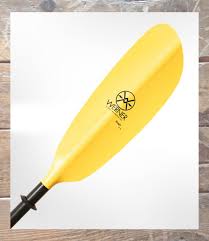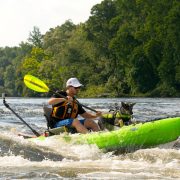For a new paddler, there are dozens of (often complicated) gear decisions to make, one of the most mystifying is paddle selection. When it comes to recreational kayaking, one of the most important factors is paddle angle. Paddle angles classifications are determined by the angle at which the paddle’s blade should enter the water. Each paddle has it’s own advantages and disadvantages, and these can be specific to the paddling activity, the size of the boat, and sometimes the size of the paddler.

High Angle Paddles (Typically 205cm-250cm)
High angle paddles have short, wide blades, and requires an aggressive forward stroke to truly reap the benefits of the blade design. This blade will provide excellent bite on the water, speed and acute control for avoiding obstacles. These are essential tools for river, ocean and surf paddling. Fishing kayakers choose High Angle when their kayak has a high seat position or if they are primarily river fishing. Recreational paddlers should try high angle paddling when river paddling and/or fitness paddling. In the case of chronic shoulder and/or back problems, high angle paddles should be avoided. Remember, keep in mind the width of your kayak when thinking about a high angle paddle – if your kayak is too wide, the aggressive angle required will likely cause you to bump the side of your kayak, ruining your cadence and possibly your day. High angle paddles excel at getting you from point a to point b, directly and in a hurry. Be mindful though that fatigue and stress on your joints and muscles can also develop in a hurry.

Low Angle Paddles. (Typically 220cm-250cm)
Low angle paddles have long, slender blades, and are used with a sweeping, easygoing stroke. This paddling design (seen in Greenland paddles) and even-tempered stroke method was used by the Inuit people, and was adapted to aid in lessening the strain on the body while spending long hours on the water hunting or fishing. Today’s modern low angle paddle uses high-tech materials and precision weighting to make the efficiency of a sweeping stroke even more profound. Consider selecting a low angle paddle anytime you are spending long hours on the water, or if you have a very wide kayak. Those with chronic shoulder and/or back pain most often prefer a low angled paddle as well, considering the gentle stroke used while paddling. River paddlers should avoid the low angle paddle – though very efficient, the narrow blade doesn’t provide the bite needed to avoid rocks and other dangerous obstacles.
The views expressed above are generalities and may change or adjust for unique cases. Remember, the most important thing is to choose the paddle that will keep you safe and happy. Speak with a paddlesports expert; they can help you make the decision that’s right for you!
Happy paddling!





